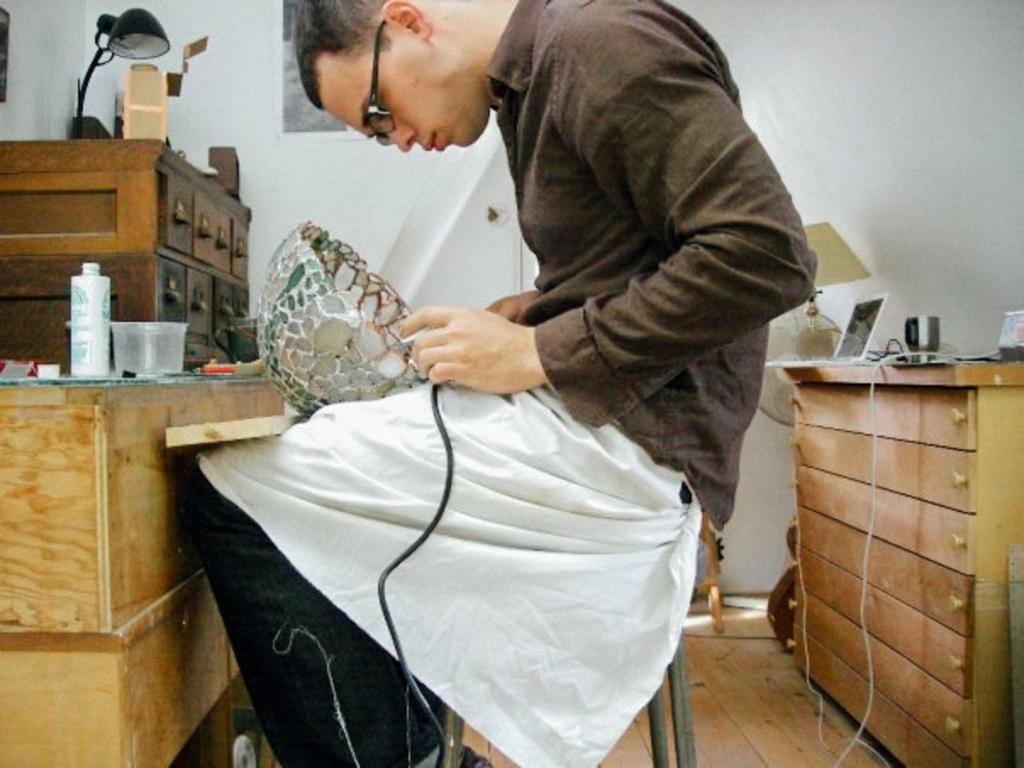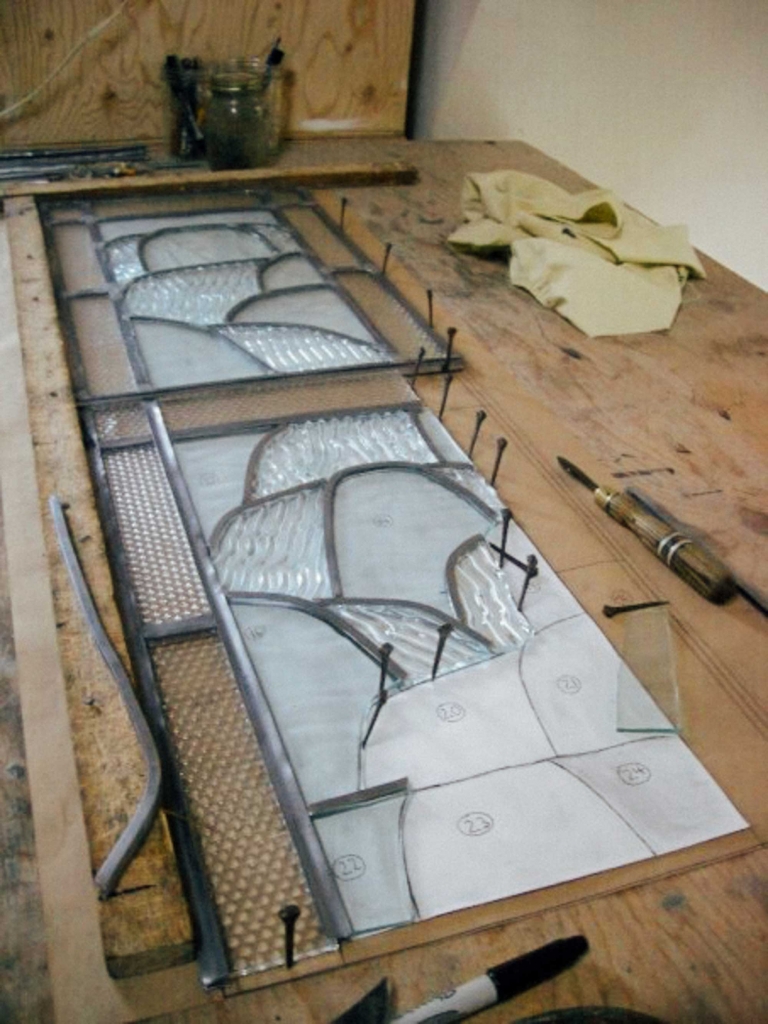New Narratives
The Importance of Being Unoriginal
Lessons on craftsmanship from a studio dropout
TEXT Mark Mann
ILLUSTRATION Vincent Toutou
In the two years that I apprenticed in a stained glass studio, I designed and built many windows, though only one was any good. Most were crap, a few were okay, but one in particular was genuinely nice. Beautiful even: a strange and self-possessed creation. And it was a copy.
I never actually wanted to be a stained glass artist. Not, that is, until about a year after graduating from university with a bachelor’s degree in literature and no clue what to do with it. Until then, I had dreamed of becoming a writer, but I soon discovered that the rigours of writing professionally totally exceeded me. Since my only other dream was to live a beautiful life, I resolved to change course entirely: I would become a craftsman. I’d learn some time-honoured trade, bring value to the world with my hands, and live from the fruits of my labour. The natural intelligence that lay dormant in my fingers would be awakened; a feeling of earned satisfaction would envelop me. It was going to be great.
Any craft would have satisfied me, as long as it sounded old-fashioned and picturesque: bookbinding, tinsmithing, basket weaving, it didn’t matter. Luckily, the father of a close friend happened to be a master glazier in London, Ontario, and he was interested in having a student. Ted Goodden makes traditional stained glass windows for residences, churches, and public buildings, working in a droll and dreamlike style that immediately appealed to me. His aesthetic combines the weirdness of folk art, the cunning of contemporary art, and the pleasure of decorative art.
It seemed like a perfect fit, so one hot July afternoon I composed a handwritten letter, formally requesting that he take me on as an apprentice at his studio. Amazingly, he accepted, and two months later I traveled over 400 miles [700 km] in a rented van, from my small Montréal apartment to Ted’s quiet studio in London, ready to embark on my new life as a stained glass artist.
If I learned one thing over the next two years, it’s that studio life is bliss. Ted worked in an old garage that had been renovated as a sort of carriage house, with a peaked roof and large picture windows at one end where finished pieces and variously sized sheets of coloured glass continually rotated. Ted’s workbench was on the main floor and mine was on the second, which ran about half the length of the studio. We shared a view of his overgrown garden and a pair of dogs—one black, one white—who played constantly in the neighbour’s backyard. Each day was more or less the same, spent standing directly above Ted’s head; we listened to the radio, chatted amiably into the space between us, and watched those two dogs play. Ted smoked a pipe, so like a good apprentice, I did too. Week after week and month after month, we smoked and talked and made windows.

Ted often spoke of glass in quasi-mystical terms: how it keeps the memory of a score line for only a short time, and then quickly forgets to break how you want it to; how, of all the colours, blue glass holds onto the light longest in the evening. At the molecular level, glass is more similar to a liquid than a solid, and it occurs naturally only at sites of heat and violence—lightning strikes, meteorites, and volcanoes.
Humans first picked up the trick of making it about five or six thousand years ago, around the eastern end of the Mediterranean. Windows were still science fiction at that point; early glass-workers just made beads and decorations. As glass-makers experimented, they discovered that various “impurities” could yield distinct colours, because different molecules block out separate parts of the light spectrum. For example, when gold is mixed into glass, it creates a lovely shade of pink. Ted kept a sheet or two in the studio, and I would sometimes hold it up to the light, studying its rosy lushness.
In the early Middle Ages, the techniques of stained glass production developed into a prized art form, worthy of the great cathedrals whose construction occupied families of craftsmen for generations. At the time, stained glass guilds jealously guarded their secrets, in much the same way that today’s artificial intelligence or quantum computing companies protect their IP. But stained glass has long since dropped from the technological cutting edge.
Though some contemporary glass artists do employ tricky chemical treatments and advanced manufacturing processes, Ted’s methods have hardly changed from those of his medieval forebears. Sure, the soldering irons we used were electric, and the grinder—for shaping and smoothing the edge of a piece of glass—had a motor, but the process was fundamentally the same. It’s not complicated; you could easily learn to assemble a window in a day or two.
Whatever secrets remain can hardly be put into words; they are revealed only through long years of practice.
From Ted, I learned that craftsmanship isn’t so much a philosophy as a rhythm. If most other jobs are either frantic or dull, the working life of a craftsman is wonderfully steady. But unlike a lot of contemporary work, craftwork has a lot of variety. Each step is different than the last. It can take 40 hours, or double that, to make a stained glass window. Along the way, you have to conceive the image, draw a design, cut out the shapes, choose and cut the glass to the design, cut and shape the lead around the pieces of glass, solder it together, rub cement under the lead, and finally frame or install the window. Each of these steps comprises many little details of execution, most of which can hardly be described, only demonstrated.


Just as Ted’s approach to window-making cleaved to age-old tradition, my education was also supposed to follow a traditional path. In the medieval guild system, the first “junior” apprenticeship is followed by a longer “journeyman” one, so called because the apprentice travels to another studio to learn from a different master. Into my second year in the studio, Ted and I started to plan for my journeyman phase. We began picking out other studios in North America or Europe where I might spend five or more years refining my craft. But by this point, my future as a master glazier had begun to appear less bright. There was something missing from my windows. They lacked loveliness or spark. Technically, my work was mostly fine, but my designs were clumsy and self-conscious.
I toiled for two months over a beach-glass lamp, and at the end found that I had tragically undermined the gorgeousness of the materials with a dumb-looking pattern of my own invention. Therein lay my problem: invention. I was unconsciously fixated on originality, but my attempts to demonstrate some brilliance or flair frequently led me to disappointment.
I’m not sure if it was intended as a corrective or simply as a teaching aid, but around this time Ted asked me to try a technique commonly employed in the Middle Ages: imitation. Rather than compose my own design, he suggested I pick an image of a medieval window and try to recreate it. Feeling somewhat relieved, I pored through the studio bookshelves and picked out an image of a curious-looking 11th century window from the Abbey Church of Saint-Denis in France. The window presented a Dr. Seuss-like snapshot of the Holy Family’s escape into Egypt after the birth of Jesus, in which Mary reaches from atop a tormented-looking donkey to pluck a piece of fruit that dangles from a floppy blue and green tree. “Stopping again?!” Jesus and Joseph seem to say, looking tired and travel-grumpy. Meanwhile, hovering in the corner is a small brown cloud that Ted and I speculated might be God.

For two months I dedicated myself to recreating this weird little scene, even as I began to dread the prospect of spending five more years in a different stained glass studio… let alone the rest of my life. Gradually, with the little skill I’d acquired, the Holy Family and one sad donkey slowly emerged on my workbench, their faces full of comic pathos. Painting and firing each piece in the kiln, I obsessed over every detail: the curve of their eyebrows, the scorched red landscape. I was high on the work, but somewhere in my mind I knew I had to get out. I needed to get back to making words appear on a page—the one craft I’d always wanted to practice.
My Escape from Egypt window came off beautifully, but as the second year of my apprenticeship wound down, I stopped looking for another studio to apprentice. Instead, I found a job I enjoyed and went back to zero on my writing career, working slowly in my spare time. It would take six more years before I could call myself a professional writer, but the time didn’t matter, because I finally understood what it takes to really succeed at a craft. Namely, everything. It takes your whole life. All the time you have.
It’s a humbling realization, but humility is good, because you need it to be willing to learn. If I hadn’t been so humbled by my failures that I was happy to simply imitate a great medieval window, I’d never have made anything truly beautiful during my apprenticeship. And if I hadn’t been humbled enough to realize that greatness was unattainable in just two years (or five or ten or maybe even twenty), I’d never have been able to embrace my calling with the commitment it takes. The rest is just good, steady work.
______________________
Mark Mann is an independent journalist and writer based in Montreal, specializing in narrative longform essays and reported features, as well as cultural criticism. He is a senior editor at BESIDE magazine, a contributing editor at the art publication Momus, and he produces a newsletter about the innovation economy called Research Money.
Never Miss Another Issue
Two issues per year
25% OFF previous issues
Free Shipping in Canada